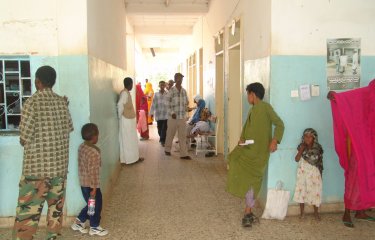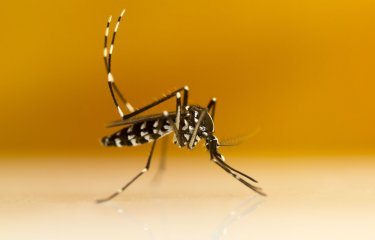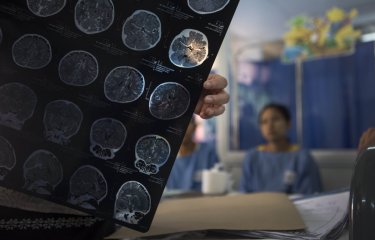Mathieu Picardeau is Head of the Biology of Spirochetes Unit and the National Reference Center for Leptospirosis at the Institut Pasteur. Mathieu is warm, friendly and well-read, with a passion for contemporary art in his free time – but what really gets him excited is a very specific family of bacteria, some of which are fatal for humans. Despite his many responsibilities, he spends time in the lab as often as he can. His work has taken him all over the world, making him only too aware that leptospirosis is an "ultra"-neglected disease.
Arts or science?
After completing high school, Mathieu wasn't sure what direction to take. He liked science, but he was also interested in photography. After much thought, he chose to study life sciences at the University of Tours, in his home region. Some of his university professors had a contagious passion for biology, confirming Mathieu's hunch that this was the right course for him.
His next stop was Pierre & Marie Curie University in Paris. For his DEA postgraduate diploma, he joined the National Reference Center for Mycobacteria, led by Véronique Vincent at the Institut Pasteur, where he discovered a whole new microscopic world. He studied "atypical" mycobacteria – those that do not cause tuberculosis or leprosy –, and went on to complete a PhD on the subject.
United States, Montana: bears, cowboys and strange bacteria
For his postdoctoral fellowship, Mathieu jetted off to Rocky Mountain Laboratories in Montana, in the United States. This renowned scientific campus is nestled in a valley between two mountain ranges. The nearest town is an hour's drive away. At the local saloon, real cowboys drink beer and play pool. In summer, when the mountains dry up, hungry bears sometimes make their way down to the research center to go through the trash.
In the lab, Mathieu would often bump into Willy Burgdorfer, the scientist who identified the pathogen that causes Lyme disease – which was subsequently named after him. Mathieu also spent time working on this bacterium, Borrelia burgdorferi.

Borrelia burgdorferi belongs to a group of bacteria known as spirochetes, which have many distinct characteristics: they are spiral-shaped and highly motile but with internal flagella, unlike most other bacteria. Their genome is also unusual because it can contain multiple chromosomes or linear forms. Growing them in the lab is difficult, genetic engineering is tricky – basically they are a biological curiosity and there is so much still to learn about them! That's why they interest me so much.
|
The spirochetes group contains pathogens that cause severe diseases in humans:
|
Leptospirosis: a disease spread through rat urine
When he came back to France, Mathieu returned to the Institut Pasteur in Paris to work in the Molecular and Medical Bacteriology Unit. There he turned his attention to another spirochete: the leptospirosis agent. Then, after the retirement of its managers, Isabelle Saint Girons and Guy Baranton, he created the Spirochete Biology unit.

There are between 600 and 700 reported cases of leptospirosis every year in mainland France, but the actual figure is probably higher. We should soon have a better idea of the real number of cases because leptospirosis became a notifiable disease in France last year (August 2023). Leptospirosis is transmitted through rat urine – the bacteria live in the rats' kidneys and are excreted in their urine. People can encounter the bacteria when cleaning their loft or cellar, or more often when in contact with fresh water. Kayakers and water sports enthusiasts know this all too well.
Leptospirosis is a zoonosis (a disease transmitted from animals to humans). All mammals, especially rodents, can be exposed to leptospirosis with varying severity of symptoms. This includes pets and farm animals, with potentially costly repercussions for farmers. Rats remain asymptomatic and carry the highly virulent strain Icterohaemorrhagiae, which can be fatal.
A neglected tropical disease and climate change
Mathieu has traveled to many countries for conferences, especially in tropical regions – including India, Thailand, Malaysia, Brazil and New Caledonia –, where the incidence of leptospirosis is 10 to 100 times higher than in France.
"During these trips, I realized how important it is to consider health as a whole. We need to study the environment, animals and humans. Inequalities, poor infrastructure and climate change are having and will continue to have an impact on local populations."
Several studies have already shown a strong link between rainy years and record case numbers, for example in relation to El Niño or La Niña in New Caledonia.

"We are trying to raise awareness of leptospirosis among the scientific and medical community to make people realize that it is an "ultra"-neglected disease.
We want to improve our understanding of the mechanisms that make some strains much more virulent than others. Developing sensitive, rapid and cheap diagnostic tools that are widely accessible would be of real benefit to patients, especially as these bacteria are susceptible to antibiotics."
|
A vaccine developed by the Institut Pasteur In the 1970s, in response to pleas from sewer workers in Paris, the Institut Pasteur developed a vaccine for leptospirosis. These workers now wear waterproof coveralls that protect them from exposure to their environment. The vaccine is still being produced by a small French company to protect people in at-risk professions. |
Key dates in Mathieu Picardeau’s career
- 1997: PhD in Microbiology
- 1998: Post-doctoral stay at the Rocky Mountain Laboratories (NIH, NIAID), Hamilton, MT
- 2001: Recruted as researcher at the Institut Pasteur
- 2007: Head of the "Biology of Spirochtes" unit, Institut Pasteur
- 2008: Director of the French National Reference Center for Leptospirosis
- 2023: Director of the WHO Collaborating Center for Reference and Reseach an Leptospirosis






